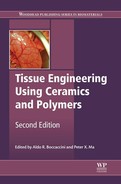Foreword
Modern medicine is under continual evolution due to the changes in our lifestyles. Changes are also needed by healthcare systems as costs increase due to the ageing population and related increase in life expectancy – which is frequently not matched by maintenance of health and quality of life.
Diagnostic products, drug therapy and surgical treatments have been supported by the introduction of medical devices. Biomaterials, the functional components of medical devices, are used extensively in the treatment of disease, trauma and disability. Some of the most significant advances have taken place in the last 40 years, with the introduction of pioneering joint and heart valve replacements through to the development of so-called bioactive materials that interact with host tissues to assist healing.
Tremendous advances have been made in biomaterials and technologies to overcome earlier limitations. Many synthetic and natural biomaterials, some biodegradable, have been introduced. Biomaterials, in the form of matrix and reinforcement (fibre and particles) have been synthesized to control specific material properties (hydrophilic/hydrophobic domains, mechanical, degradation, etc.) and to modulate biosignals through chemical and surface modification with biomolecules (peptides, amino acids, etc.), to mimic the environment of living tissues. As a consequence the disciplines of tissue engineering and regenerative medicine have recently emerged.
Knowledge of stem cells and the increasing ability to guide their fate has been a great boost for tissue engineering, regenerative medicine and advanced therapies. These new requirements impose the need for new materials and new processing methods, since biochemical, mechanical and topographical interactions have been demonstrated to be the key stimuli to trigger regenerative stem cell responses.
Thus, scaffolds may be considered to be at the centre of any successful tissue medicine strategy and provide many essential features and cues to direct the cells toward a functional outcome.
Access to nanotechnology has offered a completely new perspective to material scientists aiming to mimic the different types of extracellular matrices present in tissues. Techniques are now available which can clearly produce macromolecular structures of nanometre size with a finely controlled atomic composition and architecture. Conventional materials chemistry combined with novel methodologies such as electrospinning, direct patterning and self-assembly have been used to manufacture nanostructures which can be used to design novel advanced bio-inspired materials able to mimic different types of extracellular matrices.
Nanosystems are under intense investigation in tissue engineering to change the physical or chemical properties of biomaterials and guide the activation of specific cellular signalling. Such an approach can help design a multi-functional and cell-instructive material.
This book describes a wide range of nano-, micro- and macro-structured materials, both degradable and non-degradable, and related technologies for a number of applications. New insights in the field of tissue engineering, including biomaterials, organ regeneration, drug delivery systems, biosensors, imaging, modelling and new production technologies, are combined with a critical assessment of clinical needs. As consequence, the text offers a wealth of valuable data and experience, making it as a very useful tool for all bioengineering and materials scientists, physicians, pharmacists and other experts in a variety of disciplines, both academic and in industry.
The authors of this book, under the expert supervision of Professors Aldo R. Boccaccini and Peter X. Ma, have combined information and interdisciplinary competence in this complex field, which will contribute to educational programmes for the next generation of scientists and may help to inspire new ideas.
Department of Chemical Science and Materials Technology (DSCTM-CNR), National Research Council, Piazzale A. Moro, 7, 00185 Rome, Italy
